

Light machine gun - Kulsprutegevaer Fm/Kjellman
Picture from Carl Gustafs Stads Gun Factory Weapon Museum.
The Light Machine Guns of Sweden.
Text and pictures by O. Janson
Updated 2007-01-07
|
Index for the Swedish LMG:s - Kulsprutegevar. |
|
| Page 1 | |
|
Page 2 |
LMG BAR-family in Sweden. Kg m/21 & Kg m/37. |
| Page 3 | LMG - Kg m/1939 (BRNO ZB-26) |
| Page 4 | |
|
The Swedish light machinegun by Rudolf Henrik Kjellman. |
 |
 |
|
Light machine gun - Kulsprutegevaer Fm/Kjellman Picture from Carl Gustafs Stads Gun Factory Weapon Museum. |
|
In 1870 Lt. D. H. Friberg got a patent for his operating principles of a machine gun! The earliest drawing found are dated 1882! This was before Maxim made his machine gun. Due to the black powder ammunition which was used at that time, the gun became full with slag very fast and malfunctioned. Because of this reason nothing came out of Friberg’s invention that time. Nothing happened with the design until Sweden adopted the smokeless ammunition 6.5x55 mm - cartridge m/1894. Another Swede Rudolf Henrik Kjellman refined the design 1907. It was the locking system which was unique and it was later used in many famous automatic rifles and machine guns like the Russian DP28 and the German MG42. The feeding systems are different but the breech-locks have similarities. One of
the locking lugs on the Fm/Kjellman was positioned on top of the bolt and the other in the
bottom. |
 |
Firing striker in movement cams the locking lugs into engagement. |
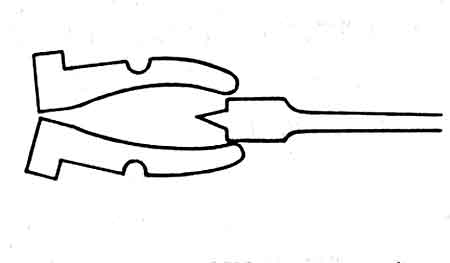 |
Firing striker in movement cams the locking lugs out of engagement. |
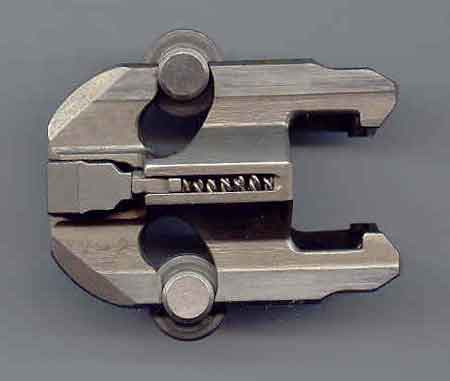 |
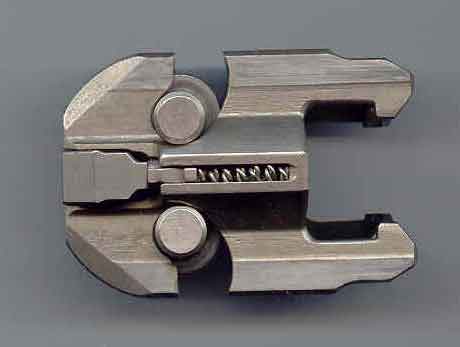 |
|
MG42 bolt locked to the left and open to the right. MG42 uses rollers instead of cams but otherwise it is the same principle. |
|
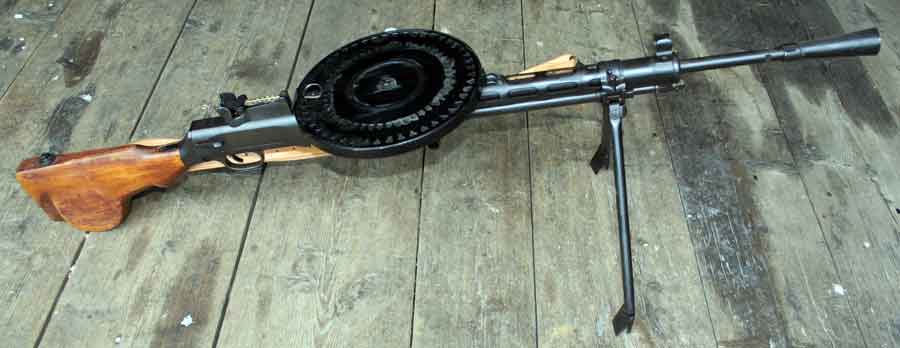 |
|
 |
Russian DP28 and its bolt |
|
The outstanding feature of this LMG was the extremely short recoil which was so utilized that it made the breech locking mechanism more secure than most other machine gun systems of its time. It has been proven that the bullet left the barrel and travelled 30 meter before the actual unlocking of the breech starts! The gun was water-cooled and had an arc type magazine positioned on top of the receiver. The arm was very reliable and accepted 1914 by the cavalry but it turned out far to expensive to produce. The production was limited to only 10 weapons! The gun is designated Fm/Kjellman in Sweden.
|
|
|
|
Light Machine Gun by Madsen M1910; similar to Swedish Kulsprutegevaer Kg m/1914 Picture from Carl Gustafs Stads Gun Factory Weapon Museum. |
Light Machine Gun by Madsen Kulsprutegevär m/1914 - Kg m/14. |
|
The Madsen Machine Gun There was a Danish engineer named Schouboe who constructed the first working Light Machine Gun around 1890. This gun was improved by another Danish - Vilhelm Herman Oluf Madsen (1844-1917) , who was then a captain of the artillery and later major general and minister of war in Denmark. He cooperated with technical genius Mr. Rasmussen, who was technical foreman at the Danish Arsenal. Odd enough this gun is known in Denmark as Madsen recoil rifle, while in the rest of the world it became known by the name of the Madsen Machine Gun. Both Captain Madsen and Mr. Rasmussen were employed by the Technical Services of the Danish Army. In order to export the Madsen LMG abroard, a company was founded in 1896 by the name of "Dansk Rekyl Riffel Syndikat A/S"
1936 it changed name to
“Dansk Industri Syndikat A/S” (DISA), in public known as Riffelsyndikatet
(the Rifle syndicate). Madsen machine guns have been chambered for most military cartridges in the world and been used in every corner of the globe at one time or another since their introduction in 1902. There are three good reasons why Madsen MG became so popular and widespread all over the world: 1. The gun is a good design and is always well made. 2. Its cost has always been relatively low. 3. It had an active prosperous worldwide sales group behind it.
From a very simple start the production increased gradually as the weapon was improved. After the Great War the big boom occurred. The factory was modernized and the quality of the weapon was improved. The original feed was a top-mounted clip magazine. Later on improved belt feeds were also used. “Experts” have claimed for years that Madsen is not a "sound" machine gun system. However, the gun works in spite of it; and is used in all climates and during the years it has proved that it works well and has a remarkable reputation for reliability. This LMG has been used all over the world from the Russian-Japanese war until after WW2.
|
|
The Swedish Kulsprutegevaer (Kg) m/1914 This nice light machine gun was the first Swedish LMG accepted as Kg m/1914 From the beginning these Danish LMG should be sold for another country but Sweden bought a large number of them. They were barrelled for 8 mm but they were rebarrelled for the Swedish 6.5 mm m/1894. This was the only modification which was made. Each magazine takes 25 cartridges. It is inserted in its pocket on the left side on top of the receiver. The magazine spring pushes two cartridges into the receiver. The right cartridge is pressed the in the chamber for extraction and ejection. Madsen MG is the only "non-ramming" action used in machine guns. All other systems of machine guns use the breechblock or its equivalent to drive the cartridge out of the feed into the chamber, but the Madsen system does not. |
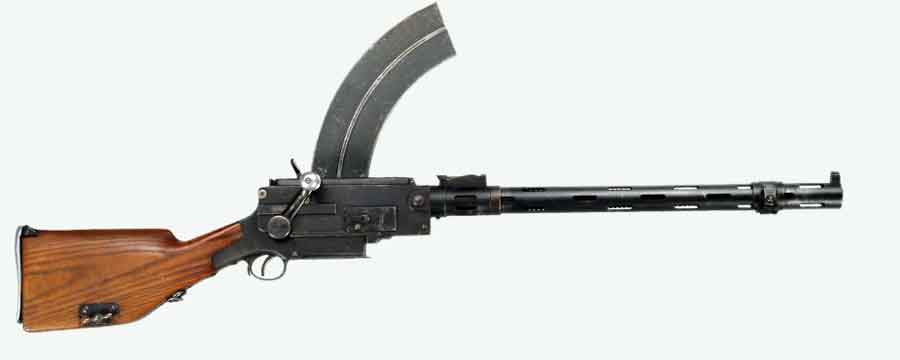 |
|
Swedish LMG - Kg m/1914 Picture from Carl Gustafs Stads Gun Factory Weapon Museum. |
|
The function of the system is shown below. The breechblock is pivoted at one end. |
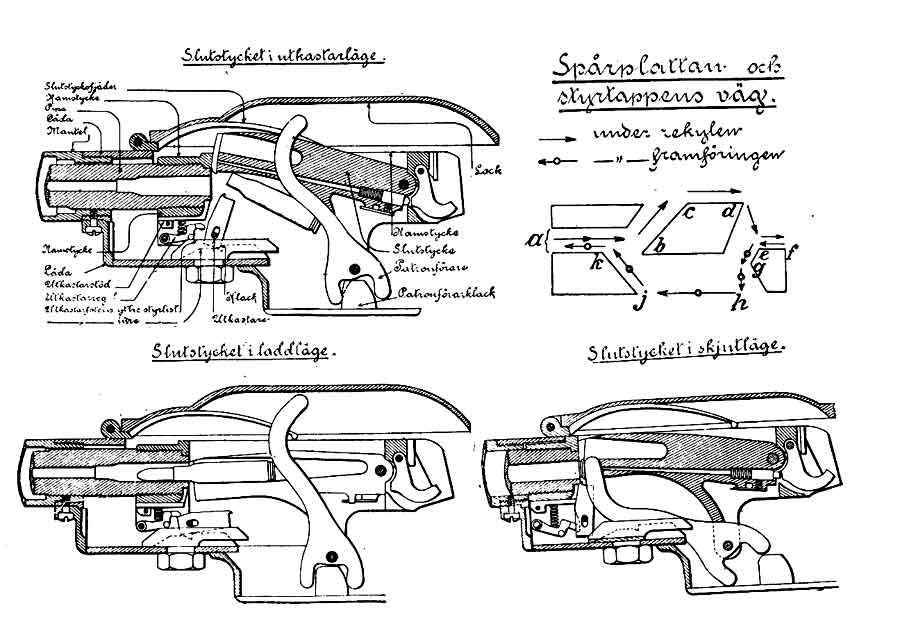 |
|
|
Drawing of Madsen LMG - Swedish Kg m/1914 |
|
|
Top left: Bolt in position for ejection On the opening action stroke it is swung up to expose the head of the cartridge case in the chamber for extraction and ejection.
|
Top right: Switch plate for the bolt and its movements When the gun fires and recoils a simple circular stud on the barrel extension operates in corresponding grooves in a switch plate ("Sparplattan") secured to the receiver, to function feed and lock; all actions take place as the barrel extension recoils when the gun fires as can be seen on the drawings. |
|
Bottom left: Bolt in position for loading On its next action the block is dropped below the barrel line to permit a fresh cartridge to be chambered. |
Bottom right: Bolt in loaded position The final motion brings the oscillating breechblock back up again into position to support the chambered cartridge as it is fired. |
| Specifications: | |
|---|---|
|
Kulsprutegevär m/14, Kg m/14 |
|
| Calibre | 6,5x55 |
| Ammunition | 6,5 mm m/94 |
| Feed | 25-round magazine |
| Rate of fire | 7 /s |
| Design | Jens Schouboe |
| Action | Recoil operated, falling block |
| Manufacturer | Dansk Rekylriffel Syndikat (DRS) |
| Year of delivery | 1914 |
| Quantity | |
| Barrel | 580 mm |
| Length | 1120 mm |
| Weight | 8 kg |
| Sights | 200-2000 m |
| Status | Obsolete |
|
Index for the Swedish LMG:s - Kulsprutegevar. |
|
| Page 1 | |
|
Page 2 |
LMG BAR-family in Sweden. Kg m/21 & Kg m/37. |
| Page 3 | LMG - Kg m/1939 (BRNO ZB-26) |
| Page 4 | |
|
References:
Swedish Army: Instruction for the soldier of the
infantry 1943 |